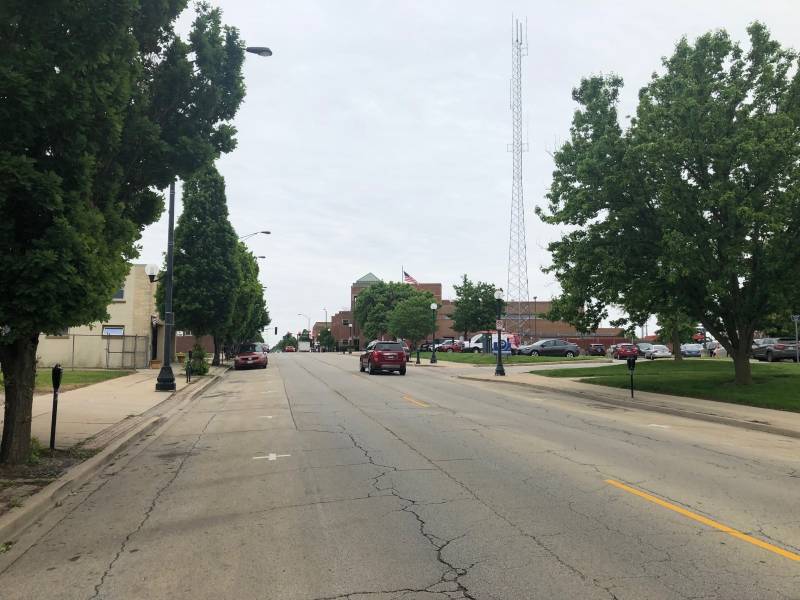First Street’s varying landscapes make it difficult to paint the road with a single, broad brush. Do you know it best in its suburban form when it traverses Research Park, or its bumpy, rural portions through University farms? Is it the border between Campustown and the more rugged “Seniorland” just to its west? Or a mid-rise street dotted with small businesses that demarcates the beginning of a recently-branded Midtown district? Perhaps the street with Prosperity Gardens?
For many years, First Street waned in its importance to Champaign-Urbana. Business development shifted from Downtown Champaign to Country Fair, then to Market Place, then North Prospect. In this half-century between the 1950s and up to the early 2000s, Downtown struggled to retain its businesses, historic building stock, and vibrancy. To its east, Campustown boomed as its single-family homes became student apartments or were fashioned into makeshift businesses over the same half-century period, a trend which continues to this day at an ever-greater scale. What is considered Campustown continued to inch westward as Downtown began its long-overdue revitalization and today, Champaign is presented with the unique opportunity to develop its Midtown district in a way that blends campus and non-campus district of the city and create a diverse, lively, and exciting district for all residents, and First Street is the key to this effort.
So far, First Street, particularly from Green Street to Washington Street has seen a wave of new development interest in the past decade following the construction of the Second Street Basin. Midtown Plaza opened as the centerpiece of the new district a year ago. Just south of that, two apartment buildings have sprung up next at the Healey and First intersection. It’s been rumored that Kam’s will relocate from its campus-adjacent location to the former Domino’s location at Green and First. A TIF district was introduced to incentivize development and make piecemeal improvements to the road. Aside from these new developments, this stretch also contains many beloved local businesses such as Maize, Am-Ko, and Dallas Costumes, just to name a few.
 North First Street lacks much of pedestrian infrastructure to link it to downtown, separated by an expansive parking lot with few dedicated pedestrian passages.
North First Street lacks much of pedestrian infrastructure to link it to downtown, separated by an expansive parking lot with few dedicated pedestrian passages.
Merging Campustown and Downtown has not been without its challenges. Despite the success of the residential portion of Midtown Plaza, after one year, all of its ground-floor retail space remains empty aside from a relocated PNC Bank branch; vacancies allow passersby to peer straight through the building to the Boneyard Basin. Development still remains largely centered around Green Street and almost solely in the form of student-oriented apartments while retail demand has been limited. In many cases, First Street is a barrier to the merging of two districts; the quality of its sidewalks and street vary and the roadway is often choked by automobiles during rush hours or large university events. North of University, First Street struggles to create a lively environment as its local businesses border a large parking lot.
First Street is growing once again in its importance to the community and a series of small interventions could better connect its adjacent communities and foster a unique experience.
 Some small interventions can change First Street from a barrier to a community asset.
Some small interventions can change First Street from a barrier to a community asset.
Firstly, the corridor should continue make improvements to its pedestrian experience. Intersections at Daniel and White/Logan are important and busy intersections for transit and foot traffic and adding traffic signals could vastly improve the safety of the street and traffic flow during rush periods. Similarly, adding crosswalks on North First Street may encourage users of the large public lot to explore some of the business offerings across the street. Reinvesting in the north side by adding amenities to Skelton Park could also stitch the North Champaign community to the downtown and Midtown areas; public funding can help expand Prosperity Gardens into an anchor for this stretch as well, potentially improving the availability of fresh produce.
Adding frequency and/or weekend service to the 14 Navy bus route could add more options along the corridor and provide stronger connections to Research Park and communities along Windsor Road. Street art, directional signs, trees, bike parking, and benches can also create a more pleasant atmosphere for people exploring the ever-changing street. Lastly, encouraging a mix of uses, specifically small businesses and offices, perhaps through a small-scale incubator, would help the First Street corridor become economically important and welcoming to all C-U residents.
As Champaign continues its Downtown and Campustown boom with potential hotels and arenas on the horizon, it may be likely that many of these improvements may be forthcoming. However, policy-making and physical developments should push the needle towards creating a “town and gown” synergy that creates and maintains inclusive housing and employment opportunities as well as benefits for Champaign’s underserved north side. First Street is an opportunity to build on the the city’s assets while preserving the unique institutions and identity of the area.
Photos by Andrew Dunham








